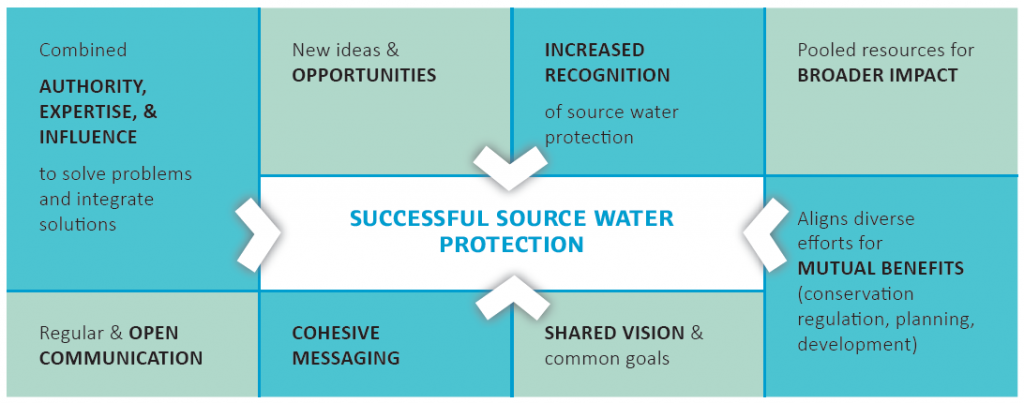This tool guides you in the development of collaborative partnerships across jurisdiction, sectors, departments, and geographic areas.
Strong and lasting partnerships are essential to source water protection.
While water suppliers do not have jurisdiction to directly act in upland watersheds, you can develop positive, working relationships with other agencies, companies, and organizations to influence practices within and outside their scope of authority.
Pooling resources—ideas, information, knowledge, efforts, and funding — leads to more shovels in the ground and better source protection overall (see Figure 2 to learn about more benefits of collaboration).
For local governments, collaboration with other departments within your organization—planning, parks and recreation, engineering, public works, finance, information technology, communications, and emergency management—also helps to realize the mutual benefits of source protection.
Good collaboration for source protection requires good coordination. Water suppliers can take a leading role in coordination through their technical advisory committees and source protection plans (see ROADMAP to Source Water Protection).
Figure 2: Benefits from collaboration
How to use this tool
The first step is to organize a technical advisory committee (also see Step 1 in ROADMAP to Source Water Protection). Your source protection plan tells you the issues you need to address, and the guide below can help you identify who to work with for each issue. You can also find industry stakeholders in your watershed using BC’s Natural Resources Online Service.
Once you have identified partners, work cooperatively to carry out the actions in your source protection plan. This way, the cumulative benefits of collaboration can be realized. Figure 3 shows which partners you should consider inviting to participate on your TAC.
Figure 3: Who to consider for your TAC
(entities involved in regulating source water concerns)
NOTE: Also consider academia, fisheries, industry & business sectors, not-for-profit groups, conservation groups and recreation clubs.
Use the best management practices in Table 8 to facilitate an efficient collaborative process.
Table 8: Collaboration guide for source water protection
1
PURPOSE
Create a shared goal for better source protection. Define the issue and point to solutions rather than pointing fingers.
2
PARTICIPATION
Actively involve groups with a significant interest in the issues and outcomes. Select representatives in a fair and open manner. Choose members with the knowledge, skills, influence, and ability to act. Ensure the timeline and budget accommodates adequate participation and engagement.
3
COMMITMENT
Ask all parties to commit to the process from the beginning through to implementation and monitoring. Create a response plan for the group. Hold meetings regularly (at least twice a year).
4
OPPORTUNITY
Provide an equal and balanced opportunity for effective participation by all parties.
5
ACCOUNTABILITY
Operate using principled negotiation, including mutual respect, trust, and understanding. Use progress reports and other metrics established as part of your source protection plan to keep members accountable.
6
GROUND RULES
Establish terms of reference and operating procedures that clarify the realities and expectations of roles, responsibilities, decision-making processes, and budget.
7
INFORMATION
Share information willingly and cooperate to gather necessary information. Incorporate high-quality information into decision-making.
8
FLEXIBILITY
Design flexibility into the process to allow for adaptation and creativity in problem solving.
9
NEGOTIATION
Understand that everyone has something to gain. Operate with mutual respect, trust, and understanding. When addressing issues, consider other perspectives and compromise on mutually beneficial solutions.
10
COORDINATION
Have an experienced facilitator to run meetings, resolve conflicts, keep the group organized and working toward goals, and keep members in sync. Add a timekeeper to ensure everyone gets their say. Plan meetings that focus on creating tangible deliverables. Take notes at each meeting that clearly outline action items and distribute them in a timely fashion. Establish and manage realistic milestones and deadlines.






